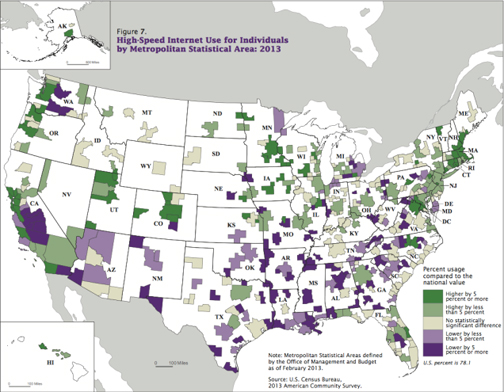Interesting new statistics from the Census Bureau concerning individual computer and Internet use in the US came out this week. Depressingly, they confirm that the Land of Enchantment is once again near the bottom. However, another study points out that the whole country, even many areas with the fastest and cheapest Internet access, likewise lags behind most of the developed world.
The government has been tracking computer and Internet usage since 1997, but last year was the first time it ever surveyed households and individuals. The basic results were recently published in a report, Computer and Internet Use in the United States: 2013 (PDF format). And they are not too far off from what one might expect: computer and Internet usage (whether desktop, laptop, or smartphone) tends to be “highest among the young, Whites or Asians, the affluent, and the highly educated.”
Which means that New Mexico, like other poor states with large minorities across the South, gets the short end of the stick. Whereas nationally 88.4% have computers and 78.1% high speed access, New Mexico (80.9% computers, 68.1% Internet) is barely above bottom-most Mississippi (80% and 62.3%).
But even in states like California and Colorado, the picture is wildly uneven. There are urban areas with high numbers of computers (Boulder, CO topping the list at 96.9% with computers) and access (Colorado Springs with 88.5% barely beaten by Corvallis, OR at 89%). Yet these, and many other Western states, have huge rural areas with little or no broadband penetration at all.
But cities in New Mexico fare badly as well: only Laredo, TX has fewer computers (69.3%) than Farmington and Brownsville, TX, both with 71.7%, but Farmington is rock-bottom with broadband for only 51.3% of the population.
There are of course differences in the way these devices are used based on demographics. Young, less affluent, Black, and Hispanic households tend to rely more only on smartphones for their Internet. While 25% households nationally don’t have any access at all, among those who do use more traditional methods, cable modems from the giant ISPs top the list at 42.8% while fiber optic and DSL together only add up to 29.2% of households.

High speed Internet for individuals by metro area.
The comparisons are even worse looking overseas at metropolitan areas. A recent report called The Cost of Connectivity 2014 analyzes the costs and speeds in 24 foreign cities and the results are even more depressing. As The New York Times puts it:
Downloading a high-definition movie takes about seven seconds in Seoul, Hong Kong, Tokyo, Zurich, Bucharest and Paris, and people pay as little as $30 a month for that connection. In Los Angeles, New York and Washington, downloading the same movie takes 1.4 minutes for people with the fastest Internet available.
The interesting thing is that a few smaller cities like Chattanooga and Kansas City have speeds and prices comparable to the best overseas. Why? “In each, the high-speed Internet provider is not one of the big cable or phone companies that provide Internet to most of the United States, but a city-run network or start-up service.”
In other words, giant Internet operators are less motivated to provide higher speeds at lower prices than local ISPs.
The reason for the American lag in speed and affordability, according to the experts, is not technology but policy – specifically the lack of competition. Wherever access is limited to a choice between the big players, like CenturyLink, Comcast, Time Warner, AT&T or Verizon, the consumer pays for it through the nose. The sad fact is that competition must be encouraged by government policy and that is not happening here.
Monopolies won’t work to improve things because they don’t have to. If you need proof, consider this: AT&T just declared it would stop investing in fiber optics in over 100 American cities. It admittedly did this in response to the President’s call for Net neutrality. This is literally holding the country’s broadband future hostage to corporate greed, and yet there has been little outcry.
While the US as a whole is stuck in the slow lane, it sometimes seems like New Mexico is a burro walking along the shoulder. The big corporations don’t care – in fact, the more pent-up demand there is, the better for them, and only them.
It’s up to regional providers like Southwest Cyberport who are eager to provide high-speed broadband to do so with services like LightSpeed. So support your friendly local Internet service providers. It seems like we’re the only ones with a carrot or a stick trying to urge this poor critter along.
